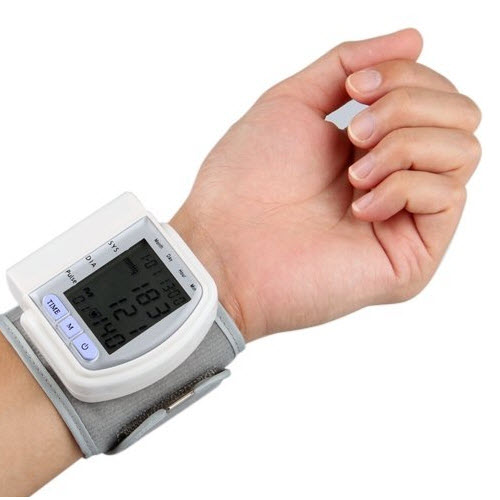Home blood pressure monitoring can provide you and your doctor with valuable information about your health. A device you use at home allows more regular blood pressure checks than occasional readings at your GP surgery.
Wrist blood pressure monitors are a convenient option for at-home use. However, they require some care to use properly. Follow some key tips and you can get accurate blood pressure readings from a wrist monitor.
What Is a Wrist Blood Pressure Monitor?
This is a device that you use yourself to measure your blood pressure. Most monitors have a cuff that wraps around your wrist. The cuff connects to a digital display that shows your blood pressure measurements.
Wrist monitors also come in wearable forms similar to a watch. These may track other health metrics like your activity levels and sleep patterns.
Using a wrist monitor allows you to check your blood pressure during normal daily activities. This provides you and your doctor a more complete view of your blood pressure outside the surgery. But wrist monitors tend to be less accurate than upper arm monitors. So doctors only recommend them in certain situations.
When Might You Need a Wrist Monitor?
Your doctor may advise using a wrist blood pressure monitor if:
- You received a diagnosis of high blood pressure (hypertension) or low blood pressure (hypotension)
- You show signs of common risk factors for high blood pressure
- New blood pressure medication has been given to you and your doctor wants to see how well it works
- You are pregnant
- Your doctor suspects you have “white coat hypertension” (high blood pressure only at the surgery) or “masked hypertension” (high blood pressure only at home)
Doctors usually recommend an upper arm cuff monitor, which is similar to the device used at your surgery. But for some people, a wrist monitor makes more sense.
Diagnosed with High or Low Blood Pressure
If you received a diagnosis of hypertension or hypotension, home monitoring can help provide your doctor a clearer picture of your overall blood pressure trends outside the surgery setting.
Your doctor may want you to check your levels at home to see how well medication and lifestyle changes are working to manage your blood pressure. Monitoring at home may also reveal if you have “masked hypertension”, meaning your blood pressure is only high when measured on your own rather than at your doctor’s office.
For low blood pressure, home monitoring can identify if you are experiencing drops that could indicate an underlying medical cause needing treatment.
At Risk for High Blood Pressure
There are several medical conditions and lifestyle factors that increase risk for high blood pressure, including:
- Being overweight or obese
- Physical inactivity
- Excessive alcohol intake
- High salt intake
- Chronic stress
- Older age
- Family history of hypertension
- Certain chronic conditions like kidney disease or diabetes
If you have one or more of these risk factors, your doctor may suggest home blood pressure monitoring even if your readings are currently normal. Tracking your levels over time could help catch early signs of hypertension.
Starting New Medication
If your doctor prescribes blood pressure medication, they will likely want you to check your levels at home. This allows you and your doctor to evaluate how well the medication is working to lower your blood pressure.
Home monitoring gives a more complete view compared to only checking at office visits. Your doctor can use your home readings to determine if medication adjustments are needed.
Continued home monitoring can also identify if your blood pressure becomes too low, which is a possible side effect of some blood pressure medications.
Pregnancy
Pregnant women face increased risk for developing high blood pressure or preeclampsia. Doctors often recommend home blood pressure monitoring during pregnancy to detect signs of these dangerous conditions.
Tracking your blood pressure daily in the second half of pregnancy can help identify preeclampsia, allowing early treatment to prevent complications. Notify your midwife promptly if you notice a spike in your readings.
After giving birth, continue monitoring blood pressure for several weeks to ensure it returns to a healthy level. Your doctor may adjust medication started during pregnancy as your blood pressure normalizes.
Is a Wrist Monitor Right for You?
Talk to your doctor before buying any blood pressure device. The American Heart Association advises monitors that fit your upper arm over your wrist. Upper arm monitors tend to be more reliable.
However, a wrist monitor may suit you if:
- A cuff monitor does not fit well on your upper arm
- You have medical conditions making upper arm devices unsafe or painful
Your doctor can decide if a wrist monitor is appropriate for you. They will know if you have reasons a cuff monitor would not work well. Your doctor can also advise how to use a wrist monitor to get accurate results.
Are Wrist Monitors Accurate?
Doctors normally recommend upper arm monitors as the most accurate. But wrist monitors can provide precise readings when you closely follow usage instructions, including positioning your arm properly
Wrist monitors tend to work better than fingertip monitors as they are more accurate. You can take your wrist monitor to your next appointment so your doctor can check its accuracy.
How to Use a Wrist Blood Pressure Monitor
Before using a new monitor, take it to your doctor to validate the accuracy. Your doctor can compare wrist and upper arm monitor readings in their office. This will reveal if your device provides accurate readings at home.
To get the most out of your monitor, you should:
- Use proper technique
- Keep a log of readings to share with your doctor
- Learn what is normal for you
Use Proper Technique
Incorrect technique can lead to inaccurate blood pressure readings. When you bring your monitor to your appointment, ask your doctor to demonstrate proper technique. Practicing the right method before using the monitor at home can help.
Follow these steps when measuring your blood pressure at home:
- Avoid caffeine, tobacco, and exercise for 30 minutes before taking your blood pressure. Also use the toilet and sit still for five minutes.
- Decide which arm you will use. This is the arm that needs proper positioning. Your other arm can be in a comfortable position.
- Sit in a chair with both feet flat on the floor.
- Position your chair facing a flat surface like a table directly in front of you.
- Put the cuff on your wrist and secure it.
- Rest your elbow on the table.
- Gently place your hand on your chest so your wrist is level with your heart.
- Relax and remain in this position before starting the measurement.
- Take the measurement without moving or talking.
When checking your blood pressure, avoid:
- Having your wrist above or below heart level
- Resting your wrist on the table or your lap
- Keeping your arm vertical
Keep a Blood Pressure Log
Your monitor may store readings in its memory. But you should still write down all your results in a notebook to share with your doctor. You can also print and use blood pressure logs available online.
Ask your doctor what details to include in your log. General guidance includes:
- Note the date and time of each reading.
- Take your blood pressure twice daily, such as before breakfast and before bed. For each time, take two back-to-back measurements. So you would record four readings per day. Ask your doctor how many days per week to check.
- Jot down any relevant notes for the day. Make note if you have had a troublesome day at work, of if you had trouble sleeping, or you felt ill. Your doctor may also want you to record when you take certain medications.
Learn What’s Normal for You
Some people naturally have lower blood pressure like 90/60 mmHg. For others, that level could indicate a problem. Before using a home blood pressure monitor, ask your doctor:
- What is a normal blood pressure range for me?
- What level is high for me?
- What level is low for me?
- How should I contact the GP if I have questions about my readings?
When Medical Help is Needed
You should seek help if your blood pressure has increased to 180/120 mmHg or above, you are having high blood pressure symptoms, or you do not feel well and are worried about your blood pressure, you may be experiencing a hypertensive crisis which is a medical emergency. Call 999 immediately.
Call your doctor if:
- Your blood pressure is higher or lower than usual for you
- You have trouble using your home monitor
- You have questions about your readings
Talk to your doctor before purchasing a wrist blood pressure monitor. Many devices are available, and it can be difficult to know which are best for you.
Also, remember that home devices do not replace medical care. They supplement measurements and advice from your doctor. Be sure to get your blood pressure and other vital signs checked at regular visits with your doctor.
Zoom Health Recommends:
Kinetik Wellbeing Advanced Wrist Blood Pressure Monitor
The Kinetik Wellbeing Advanced Wrist Blood Pressure Monitor (WBP3) from Zoom Health offers a convenient way to monitor your blood pressure from the comfort of home. Home monitoring provides a more complete picture of your overall blood pressure trends compared to occasional readings at your doctor’s office.
This clinically validated monitor provides features to help you effectively manage your blood pressure. The cuff fits wrists between 13.5-21.5cm and the positioning sensor ensures you have the proper fit for accurate results. Readings display clearly on the large digital screen.
For informed blood pressure management, the monitor averages your last 3 readings as recommended by the British Hypertension Society. This gives a more consistent overview of your levels instead of reacting to each individual reading.
The irregular heartbeat detector provides an important alert to possible arrhythmia you may not notice on your own. This allows you to seek medical advice in case of concerning new symptoms.
With storage capacity for 120 readings for 2 users, this wrist monitor enables monitoring blood pressure for two people. This makes it a versatile option for couples or families wanting to track their health metrics at home.
The simple indicator lets you know whether your reading falls in the optimal, normal, medium, high or very high range. This clear classification takes the guesswork out of interpreting your numbers over time.
Relying on your doctor’s office readings alone may miss instances of “white coat hypertension”, where anxiety during visits artificially raises your blood pressure. Or “masked hypertension”, where readings are normal at the office but elevated at other times.
Home monitoring identifies these patterns, giving your doctor a more rounded view. This allows appropriate treatment if lifestyle changes or medication are needed to reduce health risks associated with uncontrolled hypertension.
For those starting new blood pressure medication, home monitoring under your doctor’s supervision can provide valuable feedback on how well the treatment is working for you. Your doctor can make adjustments as needed based on your home readings.
Consistent home monitoring can also catch potentially dangerous drops in blood pressure that may occur as a side effect of some medications. This allows prompt adjustment to keep your levels in a healthy range.
The ability to store readings for two users makes this wrist monitor a flexible option whether you want to track your own blood pressure or monitor blood pressure for you and your partner or another family member.
In association with St John Ambulance, this clinically validated monitor follows protocols to provide accurate, consistent results you can rely on and share with your doctor. Proper blood pressure monitoring is key for identifying issues early and making adjustments to reduce health risks.
For convenient, comfortable at-home use, the Kinetik Wellbeing Advanced Wrist Blood Pressure Monitor checks important boxes for accuracy, easy readings, data storage, and irregular heartbeat detection. Monitoring your levels consistently in the comfort of home provides you and your doctor key insights for staying healthy.
Photo by Anthony Cunningham for Zoom Health
Zoom Health is a leading UK supplier of Home Health Tests and Earplugs






